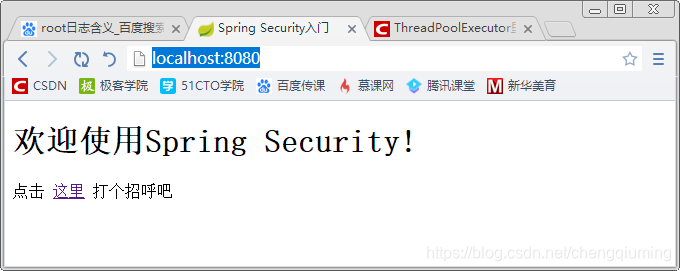Spring Boot中使用Spring Security進行安全控制
阿新 • • 發佈:2018-12-19
一 點睛
我們在編寫Web應用時,經常需要對頁面做一些安全控制,比如:對於沒有訪問許可權的使用者需要轉到登入表單頁面。要實現訪問控制的方法多種多樣,可以通過Aop、攔截器實現,也可以通過框架實現(如:Apache Shiro、Spring Security)。
本篇將具體介紹在Spring Boot中如何使用Spring Security進行安全控制。
二 實戰
1 引入相關依賴
<dependencies> <dependency> <groupId>org.springframework.boot</groupId> <artifactId>spring-boot-starter</artifactId> </dependency> <dependency> <groupId>org.springframework.boot</groupId> <artifactId>spring-boot-starter-test</artifactId> <scope>test</scope> </dependency> <dependency> <groupId>org.springframework.boot</groupId> <artifactId>spring-boot-starter-web</artifactId> </dependency> <dependency> <groupId>org.springframework.boot</groupId> <artifactId>spring-boot-starter-thymeleaf</artifactId> </dependency> <!--引入security--> <dependency> <groupId>org.springframework.boot</groupId> <artifactId>spring-boot-starter-security</artifactId> </dependency> </dependencies>
2 新建控制器
package com.didispace.web; import org.springframework.stereotype.Controller; import org.springframework.ui.ModelMap; import org.springframework.web.bind.annotation.RequestMapping; import org.springframework.web.bind.annotation.RequestMethod; @Controller public class HelloController { @RequestMapping("/") public String index() { return "index"; } @RequestMapping("/hello") public String hello() { return "hello"; } @RequestMapping(value = "/login", method = RequestMethod.GET) public String login() { return "login"; } }
3 安全配置
package com.didispace; import org.springframework.beans.factory.annotation.Autowired; import org.springframework.context.annotation.Configuration; import org.springframework.security.config.annotation.authentication.builders.AuthenticationManagerBuilder; import org.springframework.security.config.annotation.web.builders.HttpSecurity; import org.springframework.security.config.annotation.web.configuration.EnableWebSecurity; import org.springframework.security.config.annotation.web.configuration.WebSecurityConfigurerAdapter; @Configuration //通過@EnableWebSecurity註解開啟Spring Security的功能 @EnableWebSecurity //必須繼承WebSecurityConfigurerAdapter public class WebSecurityConfig extends WebSecurityConfigurerAdapter { @Override //重寫該方法來設定一些web安全的細節 protected void configure(HttpSecurity http) throws Exception { http .authorizeRequests() //通過authorizeRequests()定義哪些URL需要被保護、哪些不需要被保護。 .antMatchers("/", "/home").permitAll() // /和/home不需要任何認證就可以訪問。 .anyRequest().authenticated() //其他的路徑都必須通過身份驗證 .and() .formLogin() //當需要使用者登入時候 .loginPage("/login") //轉到的登入頁面 .permitAll() .and() .logout() .permitAll(); } @Autowired public void configureGlobal(AuthenticationManagerBuilder auth) throws Exception { auth .inMemoryAuthentication() //在記憶體中建立了一個使用者,該使用者的名稱為user,密碼為password,使用者角色為USER。 .withUser("user").password("password").roles("USER"); } }
4 啟動類
package com.didispace;
import org.springframework.boot.SpringApplication;
import org.springframework.boot.autoconfigure.SpringBootApplication;
@SpringBootApplication
public class Application {
public static void main(String[] args) {
SpringApplication.run(Application.class, args);
}
}5 hello.html
<!DOCTYPE html>
<html xmlns="http://www.w3.org/1999/xhtml" xmlns:th="http://www.thymeleaf.org"
xmlns:sec="http://www.thymeleaf.org/thymeleaf-extras-springsecurity3">
<head>
<title>Hello World!</title>
</head>
<body>
<h1 th:inline="text">Hello [[${#httpServletRequest.remoteUser}]]!</h1>
<form th:action="@{/logout}" method="post">
<input type="submit" value="登出"/>
</form>
</body>
</html>6 index.html
<!DOCTYPE html>
<html xmlns="http://www.w3.org/1999/xhtml" xmlns:th="http://www.thymeleaf.org"
xmlns:sec="http://www.thymeleaf.org/thymeleaf-extras-springsecurity3">
<head>
<title>Spring Security入門</title>
</head>
<body>
<h1>歡迎使用Spring Security!</h1>
<p>點選 <a th:href="@{/hello}">這裡</a> 打個招呼吧</p>
</body>
</html>7 login.html
<!--
Spring Security提供了一個過濾器來攔截請求並驗證使用者身份。
如果使用者身份認證失敗,頁面就重定向到/login?error,並且頁面中會展現相應的錯誤資訊。
若使用者想要登出登入,可以通過訪問/login?logout請求,在完成登出之後,頁面展現相應的成功訊息。
-->
<!DOCTYPE html>
<html xmlns="http://www.w3.org/1999/xhtml"
xmlns:th="http://www.thymeleaf.org"
xmlns:sec="http://www.thymeleaf.org/thymeleaf-extras-springsecurity3">
<head>
<title>Spring Security Example </title>
</head>
<body>
<div th:if="${param.error}">
使用者名稱或密碼錯
</div>
<div th:if="${param.logout}">
您已登出成功
</div>
<form th:action="@{/login}" method="post">
<div><label> 使用者名稱 : <input type="text" name="username"/> </label></div>
<div><label> 密 碼 : <input type="password" name="password"/> </label></div>
<div><input type="submit" value="登入"/></div>
</form>
</body>
</html>三 測試
1 啟動應用程式

3 點選頁面中的“這裡”連結,彈出下面頁面


5 輸入一個錯誤的認證資訊,然後點選登入,彈出如下頁面

6 輸入正確的認證資訊,彈出如下頁面


8 點選登出,彈出頁面如下

